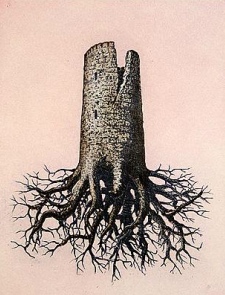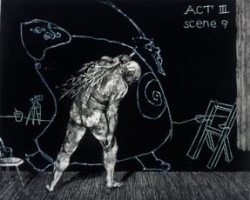
The difference I suppose is one of presence—of the energy field that envelopes the performers and the audience for the duration of the performance. It must be felt directly, it can’t be translated into video or text and transported for decoding and consumption at a remote endpoint. My first experience of Pina Bausch’s Tanztheater Wuppertal was the piece called ‘Palermo Palermo’ at the Brooklyn Academy of Music. I’d read about her work extensively, but this was my first taste.
Pina Bausch passed away yesterday, she was 68 years old. Bausch had just completed a new work, and was preparing for upcoming performances. She was one of the few artists who was required viewing in my book. If you could see a performance, there was no alternative, you must go. Now we must try to do the impossible; conjure a semblance of what it was like to be in the presence of a performance.
‘Palermo Palermo’ began with the stage completely obscured by a floor-to-ceiling wall of cinder blocks. As the lights in the auditorium dimmed, the audience was confronted with this wall. Slowly one detected movement, something was happening to the wall. It was falling backward onto the stage, and it struck with an incredible crash. The air was filled with dust, the stage was covered with broken cinder blocks, the music started up and dancers appeared—running madly across the field of broken stone.
My last encounter with Bausch’s ensemble was in Berkeley, at Zellerbach Hall. I happened to be sitting in the first row, and during a particular sequence in the performance, Dominique Mercy was asking people in the audience to make a snoring sound. This was my one contribution to Bausch’s body of work— a loud snore from the first row.
Cafe Muller
The Rite of Spring
Nelken
Walzer
Il lamento dell’imperatrice
Pina Bausch settled in, and lived her life, on the boundary between dance and theater. Her interest was not in how people move, but rather in what moves people. Her pieces were without beginning or end, constructed from the real-time lives and emotions of the dancers performing the piece. Standing at the edge, or perhaps a bit beyond it, there are no hard and fast rules about what can and cannot be included in a performance. It’s a rare artist who can consistently create passionate, engaging works from that position over a long career.
Lee Yanor’s short film on Pina Bausch captures the movement of the choreographer’s hands. Her works often had a mythic scale to them, but they began, perhaps, with her hands thinking through the movements that moved her dancers through the dance.
Pina Bausch, may “…flights of angels sing thee to thy rest.”
6 Comments



